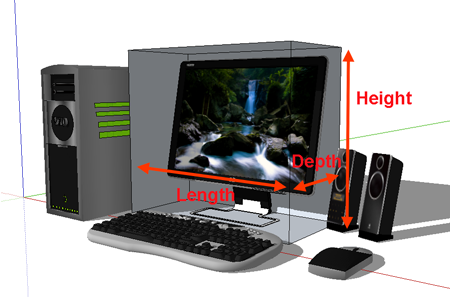Three 27" IPS LCDs: UltraSharp U2711, DS-277W, And MultiSync PA271W
Display Profile And Tilt
Manufacturers often use strange methods to measure monitors. Even at a specific LCD size, some displays take up more space than others. When you factor in the base, angle, and monitor design, you discover that viewing area isn’t the only determination of size.
We take measurements so you know how much 3D space the monitor occupies before buying.
| Brand | Dell | DoubleSight | NEC |
|---|---|---|---|
| Model | UltraSharp | DS-271W | MultiSync PA271W |
| Length | 26" | 25.5" | 25.5" |
| Height (Min.) | 18" | 17" | 16" |
| Height (Max.) | 23" | 21" | 21.5" |
| Depth (Min.) | 8.5" | 8" | 11" |
| Depth (Max.) | 10.5" | 10" | 14" |
| Weight (lbs.) | 24.78 | 22.84 | 29.88 |
The depth of these models may vary by as much as 1" if you don’t use monitor tilt. All displays are tilted to the furthest position when taking measurements. Our length and width values indicate the minimum desktop real estate you need to adequately accommodate a given model.



All three of today's test subjects tilt further than the TN-based monitors we reviewed most recently.
Current page: Display Profile And Tilt
Prev Page NEC MultiSync PA271W (27" IPS) Next Page Our Benchmarking ApproachGet Tom's Hardware's best news and in-depth reviews, straight to your inbox.
-
terr281 What monitors to review next?... As many people said in the review of the 22" TN panels from your last review, the next review should include "enthusiast available" ~23" panels. (Instead of just big box "Buy from Best Buy" models.)Reply
The lowest price of the three 22" TN panel monitors you reviewed was $180. A quick Newegg search shows several similar panels from names such as Acer, Asus, etc. starting at $140. (And, in the gaming, as well as office environments, 2 or 3 monitors are now more common than one single large one.)
-
nevertell IPS vs VA in gaming.Reply
Although just a regular sum up of the available 22-24 VA panels would be great. -
Thank you for the excellent and thorough review. Perhaps next time, the new Apple 27" Thunderbolt display can be thrown into the mix. For a lot of video and photography pros like myself, the Apple display is considered to be the "standard" and I would love to see how it stacks up again the competition. Also maybe throw in a professional level Eizo display as well to show the difference between a ~$1000 display and a $3000 display.Reply
-
120hz monitors lead the wayReply
You should review a 2560x1600 120hz IPS monitor.
Oh wait...
2560x1600 isn't supported at 120hz over DVI-D (dual link)
IPS monitors can't do 120hz with today's technology
Bummer!
:(
F -
agnickolov I'd recommend the same IPS review applied on affordable 24-26" monitors that most of us would actually potentially buy. It's nice to dream about 27"+ 2560x1440, but let's get back to reality with 24" 1920x1080 and 1920x1200 (if still available) IPS monitors please. (At least until higher resolutions enter mainstream price points.)Reply -
crisan_tiberiu I have a 22" Philips LED Backlight monitor and i am very happy with it . I dont see any Philips monitors in any of your reviews, why is that? :)Reply -
boletus Nice roundup, it had me measuring what a 26" wide monitor would look like on my desk. However, you need to fix the title block in the table for the NEC monitor on the "Black And White Uniformity" page (it says Samsung S22A350H).Reply -
soccerdocks On the "Black And White Uniformity, Viewing Angles" page the 3rd table states that it is for the Samsung S22A350H when it is actually for the NEC.Reply -
Thank you for this comparison, very interesting reading!Reply
I am somewhat disappointed that 27" monitors nowadays don't use 2560*1600 panels.
That resolution makes much more sense to me for a monitor that is not targetted at the average consumer.
Personally I would love a 2560*1920 (or 2048) screen @ 120Hz, but if I understand correctly link speed becomes an issue here.
Why is it that displays for mobile phones are increasing in pixel density, but desktop displays don't improve in this regard?
For a next review I would really like to get a better understanding of (high-resolution) 120Hz monitors. What are the (dis)advantages of 120Hz for regular/2D usage, etc...
